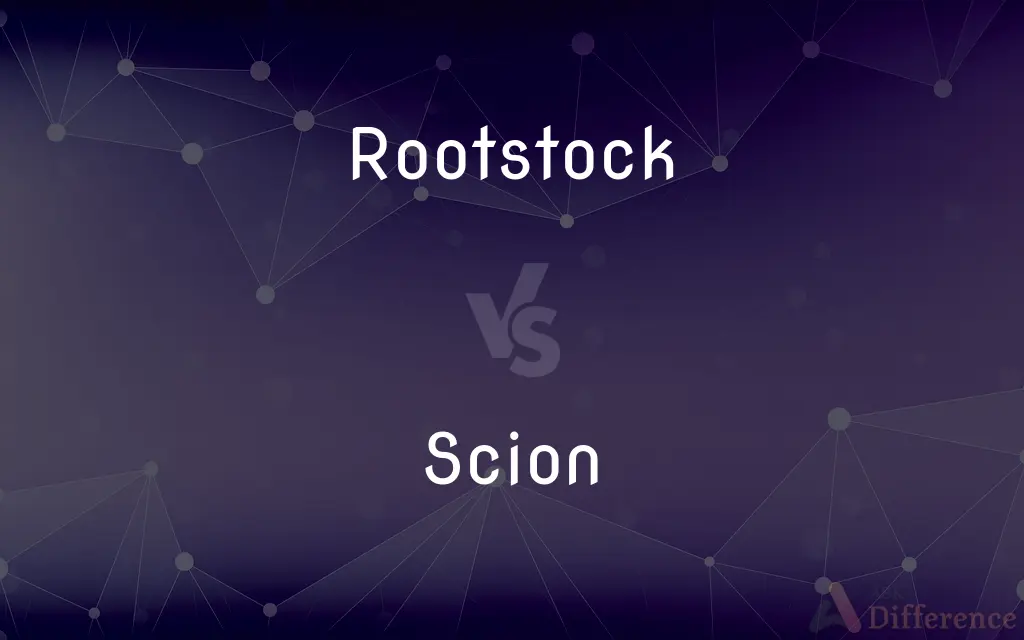Rootstock vs. Scion — What's the Difference?
By Fiza Rafique & Maham Liaqat — Updated on April 8, 2024
Rootstock refers to the root part of a plant used in grafting, providing support and nutrient absorption, while a scion is the upper part, grafted onto the rootstock, which determines the fruit or flower type.

Difference Between Rootstock and Scion
Table of Contents
ADVERTISEMENT
Key Differences
Rootstock, in horticulture, is the part of a plant that provides the root system for a grafted plant, selected for its robustness, disease resistance, and adaptability to soil and climate conditions. Scions, on the other hand, are chosen for the quality of fruit, flowers, or other desired attributes they produce, grafted onto the rootstock to combine the strengths of both parts.
The choice of rootstock can significantly affect the growth rate, size, and yield of the grafted plant, with different rootstocks offering varying degrees of vigor and resilience to environmental stresses. Whereas scions are selected based on the characteristics of the aerial parts, such as fruit size, taste, and resistance to pests and diseases, emphasizing the importance of matching scion traits with rootstock benefits.
Rootstocks are often used to propagate plants that are difficult to grow from seed, or to impart desirable characteristics, such as dwarfism or enhanced productivity. Scions, while determining the specific type of fruit or flower, rely on the rootstock for water, nutrients, and overall health, showcasing a symbiotic relationship between the two.
In grafting, the compatibility between rootstock and scion is crucial for the success of the union. The rootstock must be able to efficiently join with the scion, ensuring a seamless flow of nutrients and water. Conversely, the scion must be capable of integrating well with the rootstock to ensure that the grafted plant functions as a single, healthy organism.
The process of selecting rootstocks and scions is a critical aspect of horticulture, with research and experimentation continually being conducted to find the best combinations for different environmental conditions and plant varieties. This illustrates the scientific and practical considerations behind grafting, aiming to optimize plant health, yield, and resistance to challenges.
ADVERTISEMENT
Comparison Chart
Definition
The root part of a plant used in grafting.
The upper part of a plant grafted onto the rootstock.
Purpose
Provides support, absorbs water and nutrients.
Determines the type of fruit or flowers.
Selection Criteria
Disease resistance, adaptability, growth control.
Fruit quality, flower characteristics, pest resistance.
Role in Grafting
Base to which the scion is attached.
Grafted onto the rootstock to produce specific attributes.
Impact
Affects plant size, health, and yield.
Determines the specific attributes of the yield, like taste and appearance.
Compare with Definitions
Rootstock
The underground part of a graft.
The rootstock provides the necessary nutrients to the scion.
Scion
The upper part of a plant that is grafted onto a rootstock.
The scion was carefully selected for its superior fruit quality.
Rootstock
The base part of a plant onto which another plant section is grafted.
The apple tree rootstock was chosen for its disease resistance.
Scion
A detached living portion of a plant joined to a rootstock.
The gardener grafted a pear scion onto an apple rootstock.
Rootstock
The foundation of a grafted plant's root system.
The rootstock's health is crucial for the overall plant's success.
Scion
The aerial part of a plant that has been grafted.
The scion began to show new growth within weeks of grafting.
Rootstock
A root or stem used for the propagation of grafts.
Selecting the right rootstock can drastically improve yield.
Scion
The portion of a grafted plant that grows from the union upward.
The scion determines the variety of the apple produced.
Rootstock
A plant or plant part capable of regenerating into a whole plant.
He used a sturdy rootstock to ensure the graft would take.
Scion
A shoot or twig containing buds for grafting.
Each scion was cut to include at least two buds.
Rootstock
A rootstock is part of a plant, often an underground part, from which new above-ground growth can be produced. It could also be described as a stem with a well developed root system, to which a bud from another plant is grafted.
Scion
A descendant or heir, especially of a wealthy or prominent family
Scion of the ruling dynasty.
Rootstock
A root system of a plant, often with a portion of the stem, to which a shoot or bud is grafted.
Scion
(Botany) A detached shoot or bud from a plant that is joined to a rootstock in grafting.
Rootstock
See rhizome.
Scion
A descendant, especially a first-generation descendant of a distinguished family.
Rootstock
(agriculture) A healthy and vigorous-rooted plant that is used in grafting, most commonly as a sound base to support a scion that bears desirable fruit in orchard culture.
Scion
The heir to a throne.
Rootstock
(by extension) The necessary basis for something to develop.
Scion
A guardian.
Rootstock
A perennial underground stem, producing leafly s ems or flower stems from year to year; a rhizome.
Scion
(botany) A detached shoot or twig containing buds from a woody plant, used in grafting; a shoot or twig in a general sense.
Rootstock
A horizontal plant stem with shoots above and roots below serving as a reproductive structure
Scion
A shoot or sprout of a plant; a sucker.
Rootstock
Root or part of a root used for plant propagation; especially that part of a grafted plant that supplies the roots
Scion
Hence, a descendant; an heir; as, a scion of a royal stock.
Scion
A descendent or heir;
A scion of royal stock
Common Curiosities
What are the benefits of grafting?
Grafting combines the best characteristics of the rootstock and scion, such as disease resistance and fruit quality, and can also speed up fruit production.
What is the purpose of using a rootstock in grafting?
Rootstocks are used to provide a strong, disease-resistant foundation, control growth, and improve nutrient absorption.
Can any scion be grafted onto any rootstock?
No, the scion and rootstock must be compatible in terms of growth requirements and physical connection for the graft to be successful.
How is a scion chosen for grafting?
A scion is selected based on the desired characteristics of the fruit or flowers it produces, such as size, taste, or color.
Does grafting affect the fruit's taste?
The taste of the fruit is determined by the scion; however, the rootstock can influence overall plant health and, indirectly, the quality of the fruit.
Can grafting be done at any time of year?
The best time for grafting depends on the plant species but is generally in late winter or early spring before new growth begins.
How do you care for a grafted plant?
Care involves regular watering, mulching, and sometimes staking, along with monitoring for pests and diseases.
Why are some rootstocks disease resistant?
Through selective breeding and natural adaptation, some rootstocks have developed resistance to common soil-borne diseases.
Are grafted plants more expensive?
Yes, due to the additional labor and expertise required in grafting, these plants are often more expensive than non-grafted ones.
How long does it take for a graft to heal?
Healing time varies but typically ranges from a few weeks to several months, depending on the plant species and conditions.
Is grafting only used for fruit trees?
While common in fruit trees, grafting is also used in flowers, vegetables, and ornamental plants to achieve desired traits.
What happens if a graft fails?
If a graft fails, the scion will not properly integrate with the rootstock and will eventually die. The reasons for failure can include improper technique, incompatible match, or disease.
Can grafting be used to repair damaged trees?
Yes, grafting can sometimes be used to repair or replace damaged parts of trees, a technique known as bridge grafting.
Can a single rootstock support multiple scions?
Yes, a technique known as multi-grafting allows different varieties to grow from the same rootstock.
How do rootstocks control plant size?
Certain rootstocks can limit the growth of the grafted plant, making it more manageable and often increasing the fruit yield relative to tree size.
Share Your Discovery

Previous Comparison
Occupied vs. Vacant
Next Comparison
Sharp vs. ClearAuthor Spotlight
Written by
Fiza RafiqueFiza Rafique is a skilled content writer at AskDifference.com, where she meticulously refines and enhances written pieces. Drawing from her vast editorial expertise, Fiza ensures clarity, accuracy, and precision in every article. Passionate about language, she continually seeks to elevate the quality of content for readers worldwide.
Co-written by
Maham Liaqat













































